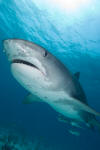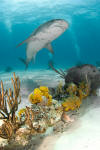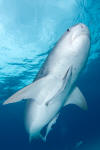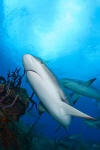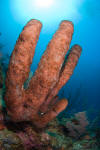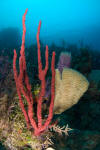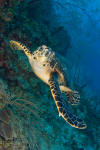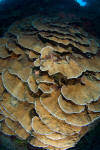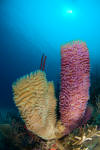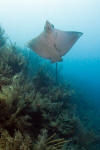Dive in strange places long enough and you'll eventually see strange sharks and rays...
I spend a lot of time blogging about my future shark photography plans which can be fun, but its so much better to be able to write about successful adventures!
After shooting three new species of deep water skates in Rhode Island (see previous post), I flew down to West Palm Beach to meet up with a group of keen shark photographers that were accompanying me on the Tiger Beach Shark Photography Workshop.
The expedition was a huge success. Tiger Beach always has a healthy supply of lemon sharks (usually around 40 or 50 once the chum gets going) but the tigers themselves can be hit and miss. Its important to have a solid player - a shark that isn't afraid of cameras, swims close to the group and stays around long enough for everyone to get the shots they want. Fortunately, that is exactly what we had. Other sharks came and went but one respectably sized tiger shark stayed with us for the entire week. I think that everyone got more tiger shark shots than they knew what to do with.
I wanted everyone to come home with great shots, a better knowledge of workflow (Bridge, Photoshop, etc) and some amazing stories about close up encounters with big sharks. I think everyone learned a lot and had a great time and I'm really looking forward to doing this again next year!
As well as lemons and tigers we had one little nurse shark that kept skirting the action. He was pretty brave to get as close as he did with all the huge carcharanids milling about but the poor guy never made it to the food.
We spent the entire week exploring all the different photography opportunities that Tiger Beach has to offer except for one afternoon that we snuck off to a deeper site to chase Caribbean reef sharks. After the big lumbering lemons it was great to play with some zippy little sharks for a few hours. Everyone hunkered down next to the reef and snapped away while the sharks buzzed back and forth above us perfectly framed against the clear blue Bahamian water.
We returned to Tiger Beach to find our super model tiger shark still in residence and continued looking for the perfect shot until it was time to pull anchor and head back to Florida.
After bidding farewell to a boat load of new friends, I packed up my cameras and took a flight to Honduras.
Steve Fox (Owner of the luxurious Deep Blue Resort in Utila) had graciously invited me to come and photograph a couple of deep water shark species that local fishermen sometimes encounter on the deep coastal plains around the island.
Both species we were after are rarely if ever photographed and both are data defficient according to the IUCN Red List. They are caught incidentally in other fisheries and like many deep sea species they are probably in decline. Sadly, if you chase rare sharks you have to expect to strike out now and then and on this trip the sharks eluded us.
Cutting my losses, I spent the next week snorkeling in a muddy lagoon looking for a rare stingray called the chupare stingray (aka Caribbean whiptail stingray).
Steve (who has a cutting British wit) ribbed me relentlessly during the week when I wasn't able to find one. He was adamant that they were all over the place if only I'd open my eyes, but trying to shoot one in the low visibility environment was an extremely challenging mission.
Through a combination of luck and stubbornness, I finally cornered a ray in a pocket of mangrove and fired off a fusillade of shots while the ray kicked up more and more silt until there was nothing left to see.
Although I didn't get the quality of images I would have liked, I did take some usable ID shots so the trip was officially a success. One more species for the Elasmodiver Shark and Ray Field Guide.
Tired of swimming around in lukewarm tea all day, I decided to take a break and head out to see some of Utila's beautiful reefs with the sensible divers. Deep Blue Resort has a seamless system for delivering divers to wonderful environments and encounters: After a leisurely breakfast, you simply stroll onto Deep Blue's private dock and get whisked off to a stunning and dramatic wall dive somewhere then climb back on board and slip out of your dive gear while the crew find you some whale sharks to play with.
Then you jump in, snorkel with the sharks (which are conveniently feeding at the surface on baitballs) and pop back onto the boat once the sharks move too deep. This is repeated time and again until the guests get tired of 'whale shark jumps' and ask to be taken to another pretty dive site.
After a pleasant lunch back at the lodge, guests are then invited to head back out on the boat for more absurdly easy diving or enjoy a shore dive on the house reef. After a week of paradise they all fly home feeling ten years younger. It's painfully easy.
I'm not jealous - really I'm not. But how come my dive trips more often involve squeezing onto a Central American school bus jammed full of locals that are carrying hundreds of chickens to some far away market. And then, sleeping on a grubby panga in the middle of the ocean with a bunch of fishermen that I can barely understand while waiting for a hapless shark to swim by. I think it's time I reconsidered my shooting strategy :)
Its been so long since I did any 'recreational diving' that at first I couldn't remember what I was supposed to look at. After a while, I settled in and started shooting pretty sponges and coral formations but it still felt kind of weird not being on a shark photography mission. The whale shark jumps were much more familiar and I was happy to have the chance to snorkel (if only briefly) with a couple of big animals.
What was more unexpected was the pod of rough-toothed dolphins that we encountered. I am far from a marine mammal expert and I confess that I'd never even heard of rough-toothed dolphns. Apparently they encounter them on Utila fairly regularly and these ones were surprisingly playful. I was the only one free diving so the dolphins gave me a lot of attention and I came away with some very respectable images. I'd like to share them here but they are earmarked for a future publication. Here's one that didn't make the cut:
Having got my fix of big aquatic animals, I decided to head back into the lagoon for one more crack at the Caribbean whiptail rays. The vis had improved enough to see the mangrove forest in all its glory but the rays were nowhere to be found.
What I did stumble upon was a urolophid ray (round stingray family) that I can't positively identify. It was probably just a yellow spotted stingray but rather than the usual tiny yellow spots on a pale background this little ray was jet black with vividly contrasting orange/yellow spots. I've never seen this color variation before but then again I've never spent a week snorkeling around a Honduran lagoon.
Tallying up the elasmobranchs from the entire trip, over a 5 week period I managed to shoot nine species of sharks and rays and saw two more species distantly swimming along. Not a bad first adventure for the new decade.
Future plans...
I'm hoping to attend the American Elasmobranch Meeting in July in Providence, RI. If any of you sharkafiles will be there please let me know. After that, my next big trip will be Sharkfest. Sharkfest is three days of sandtiger shark diving with a mini shark film festival attached. It's my humble attempt to bring together a whole bunch of shark divers to dive, watch movies, tell stories and have some fun. If you would like to attend there are 3 spots left on the boat. Email me for details.
For now I'm back on Vancouver Island cleaning up pics, writing stories, diving with local species and plotting. I may be running an underwater photography workshop here in Victoria over the summer so if you're up in the Pacific North West and want to learn the basics of DSLR photography let me know!
For the sharks,
Andy Murch


